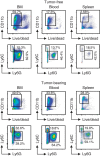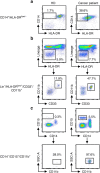Recommendations for myeloid-derived suppressor cell nomenclature and characterization standards
- PMID: 27381735
- PMCID: PMC4935811
- DOI: 10.1038/ncomms12150
Recommendations for myeloid-derived suppressor cell nomenclature and characterization standards
Abstract
Myeloid-derived suppressor cells (MDSCs) have emerged as major regulators of immune responses in cancer and other pathological conditions. In recent years, ample evidence supports key contributions of MDSC to tumour progression through both immune-mediated mechanisms and those not directly associated with immune suppression. MDSC are the subject of intensive research with >500 papers published in 2015 alone. However, the phenotypic, morphological and functional heterogeneity of these cells generates confusion in investigation and analysis of their roles in inflammatory responses. The purpose of this communication is to suggest characterization standards in the burgeoning field of MDSC research.
Figures




References
-
- Brusa D. et al. Circulating immunosuppressive cells of prostate cancer patients before and after radical prostatectomy: profile comparison. Int. J. Urol. 20, 971–978 (2013). - PubMed
-
- Gabrilovich D. et al. Vascular endothelial growth factor inhibits the development of dendritic cells and dramatically affects the differentiation of multiple hematopoietic lineages in vivo. Blood 92, 4150–4166 (1998). - PubMed
Publication types
MeSH terms
Substances
Grants and funding
- R37 GM021248/GM/NIGMS NIH HHS/United States
- R01 CA084488/CA/NCI NIH HHS/United States
- R01 CA109322/CA/NCI NIH HHS/United States
- P30 CA021765/CA/NCI NIH HHS/United States
- R01 CA184185/CA/NCI NIH HHS/United States
- R01 CA100062/CA/NCI NIH HHS/United States
- R01 CA127483/CA/NCI NIH HHS/United States
- R01 CA115880/CA/NCI NIH HHS/United States
- P30 CA010815/CA/NCI NIH HHS/United States
- R01 CA141438/CA/NCI NIH HHS/United States
- R01 CA204191/CA/NCI NIH HHS/United States
- R01 HL056067/HL/NHLBI NIH HHS/United States
- R01 GM021248/GM/NIGMS NIH HHS/United States
LinkOut - more resources
Full Text Sources
Other Literature Sources
Medical

